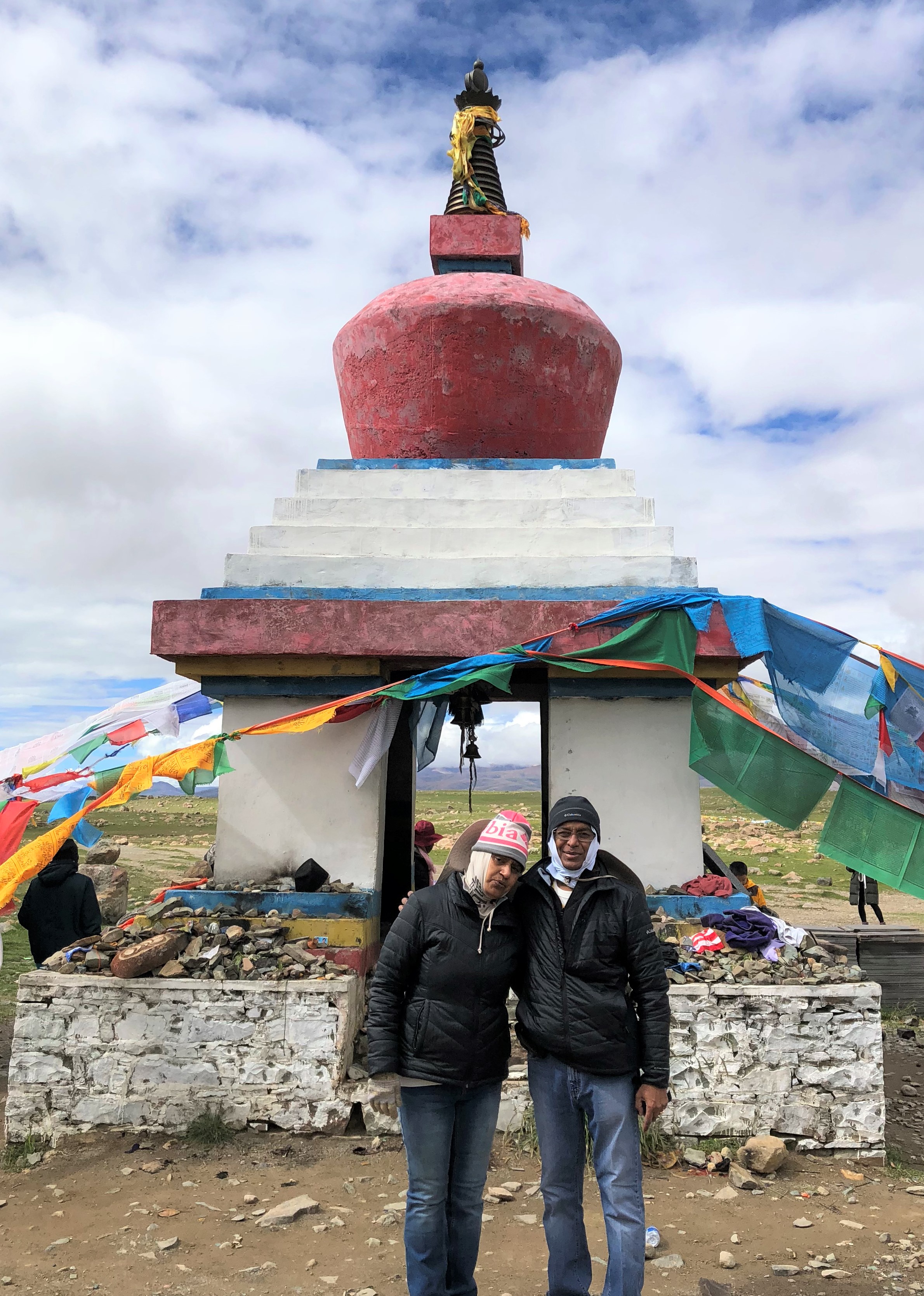By Vish and Akila Iyer
e-mails:Â vishviyer@yahoo.com and iyer1957@gmail.com
Editor’s Note: Vish Iyer, a physician, and Akila Iyer, a financial manager, live in Fox Chapel. Spirituality transcending religion, they say, is the goal they seek in life.
Mount Kailash is revered by millions of Hindus as the abode of Shiva. Pilgrimage to visit to this sacred mountain and lake Manasarovar is the life-long ambition, not only for the Hindus, but also Buddhists, Jains and the followers of the Kom religion.

The authors at Yamadwar, the start of the Parikrama.
The vedas, the sacred texts for the Hindus, do not start from the first word and end with the last one. Of the four. Rig, Yajur, Sama and Atharvana Vedas, Yajur Veda is widely practiced. Yajur Veda has 7 chapters and the middle of the fourth chapter is Sri Rudram. And the center of Sri Rudram are the syllables Si-Va. Thus around Si-Va is constructed Sri Rudram and around Sri Rudram is constructed the Veda. For the first time ever, Atirudra Mahayagna — that is chanting Sri Rudram 16,461 times — and performing Havan was organized at Mount Kailash, for world peace. Chanting Sri Rudram invokes Siva Himself and performing Yagnam (Homa) simultaneously ensures His presence.
Getting to Tibet is either via Nepal or China. We chose the Chinese route, which requires that we had to go as a group, since individual permits are not allowed in Tibet. Lhasa, the beautiful capital of Tibet, is filled with lovely people who are culturally conscious. Chinese presence is felt in every aspect of day to day living. The Potala Palace, the headquarters of the Dalai Lama is occupied by the Chinese.

 A busy thoroughfare in Lhasa, Tibet.
After acclimatizing for a day in Lhasa, we proceeded by road to Xigatse. The mighty river Brahmaputra gave us company during the long drive. After a night of acclimating in Xigatse, the next night was spent in Saga. Electricity is available only from 8 PM to midnight at Saga and other towns above this altitude.

A majestic view of Mount Kailash, the very purpose of our trip.
First stop was the sacred Lake Manasarovar where we were blessed with the sight of the third moon representing Siva Himself. There are two lakes, Lake Manasarovar and lake Rakshastal that are side-by-side. Lake Manasarovar is filled

A Tibetan Buddhist, with help from her two children, doing the parikrama. for every four steps, she does an Pranam.
with life and there are birds and other forms of life. While Lake Rakshastal is devoid of any form of life. The legend goes that the waters of lake Rakshastal is unfit for consumption as this was the place where the demon king Ravana did his penance and lifted Mount Kailash. And, the legend goes, Ravana got punished by Lord Siva who squeezed Ravana under the holy mountain.
Our base camp at Darchen is situated at an altitude of 16,500 feet. The partial pressure of oxygen gets low at these altitudes and any form of physical activity takes lot of effort. Many moons ago, as a young Captain in the Indian Army, I’ve experienced it along the Chinese border in Sikkim.
Because of various delays in delivery of Yagnam materials and other logistical hurdles, the Yagnam was delayed. We embarked on a 3-day Parikrama of Mount Kailash with basic supplies including plenty of high calorie food for the arduous trek. Each pilgrim had a porter who would carry a small backpack.

A Tibetan bride on her Big Day in he traditional Braial dress.
In addition, there was also a horse and the horseman as a back-up, if one is unable to walk. The starting point was Yamadwar near Darchen.
Buddhists believe in Parikrama, but they do full prostration after every four steps. It takes them 25 to 30 days to complete the entire length of 52 km. Bon religion has two categories, white Bon

A Buddhist Temple along the way.
that is quite compassionate and the other is Black Bon. Interestingly, those who practice Black Bon do the Parikrama in an anti-clockwise direction. Their practices are somewhat similar to Islam.
At the end of the first day, we spent the night as close to Mount Kailash as possible near the north face with a divine darshan of Mount Kailash.
The second day was the most difficult portion of the trek. It involved climbing to an altitude of 19,500 feet to Dolma La pass. The terrain was steep and uneven. Breathing was certainly challenging! Soon after we could see Gauri Kund, and also had darshan of Hayagriva. According to the Buddhists, this is one of the three

The Hayagriva Mountain Peak, a work of art by Nature done over thousands of years in bone-chilling cold and blistering winds.
holy sites of Hayagriva who they recognize as an incarnation of Lord Vishnu.
Climbing down was tricky where the surface was wet and uneven, but the breathing was definitely easier. The second night was spent in rather basic conditions in a guesthouse. Appetite

Yaks, the beasts of our burden, very critical for our trekking.
was literally nonexistent. Plenty of fluids and prophylactic medicines to prevent high-altitude sickness are vital.
The third day of the Parikrama was a lot easier on an even surface and it
involved another 20 km of trekking. At the end, it was a welcome sight to see the waiting buses to take us back to Darchen. We thanked our porters and horsemen and reached Darchen.
Our last day was partially spent in taking part on the Ati Rudra Maha Yagnam. The ambiance was divine. We thanked everyone and started our return journey. Our descent was along river Brahmaputra, back to Lhasa. One more quick appreciation of beautiful Tibet before flying back home, to Pittsburgh. Â Â ♠
